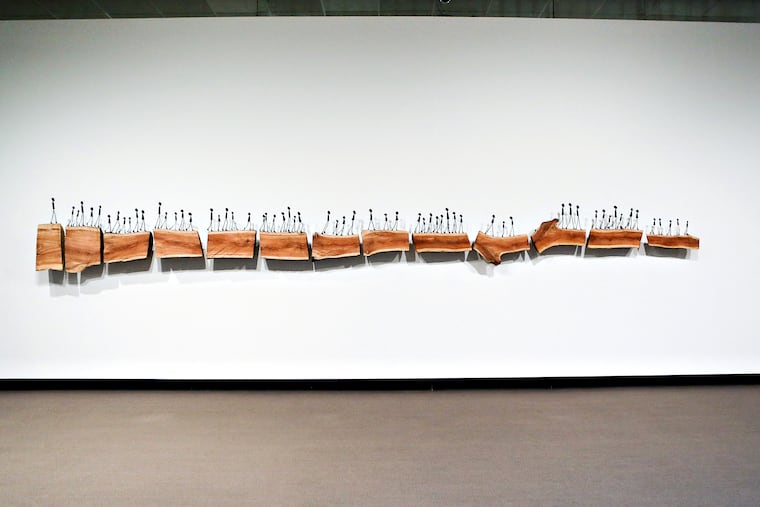‘We are here and present’ says cocurator of Lenape exhibit at the Michener Art Museum
“Never Broken: Visualizing Lenape Histories”, which opened Saturday and runs through January, shows Lenape history as told from the perspective of Lenape artists.

Growing up in the tristate area, Ahchipaptunhe was often met with blank stares when he would talk to people about being Lenape. Even though the Lenape are from this land, their existence had been erased — and, as a result, Ahchipaptunhe felt that he didn’t belong.
It wasn’t until he started creating art that Ahchipaptunhe was able to redefine what being Lenape meant to him. And as of last Saturday, he and other Lenape artists have their work on display at a new exhibit at the Michener Art Museum.
“Never Broken: Visualizing Lenape Histories” is an exhibit that aims to tell the story — past, present, and future — of the Lenape people. This exhibit, which will be on display into January, appears to be the first to focus solely on Lenape art.
The inspiration for the exhibit came from a depiction of Penn’s Treaty being conducted with the Lenape, a painting originally made by Benjamin West. The painting has been reproduced on everything from textiles to fine china to textbooks — and Laura Igoe, chief curator at the Michener, wanted to highlight the problem with the image.
“It became interpreted as an actual, factual history about the event,” Igoe said. “But Benjamin West’s painting was made 100 years after any kind of agreement with the Lenape and William Penn occurred.”
The image, Igoe said, was a form of propaganda to reassure colonists as they displaced Native Americans and cheated them of their land. So Igoe connected with Joe Baker, executive director of the Lenape Center in Manhattan and cocurator of the exhibit, to create a space that would show Lenape history as told from the perspective of Lenape artists.
‘We’re not invisible’
For Baker, a significant part of this exhibit is land acknowledgment — knowing that the Michener, and the Philadelphia area, sits on Lenape land.
“Our presence within our homeland has effectively all been erased,” Baker said. “We have been forcibly displaced through generations of hundreds of years beginning in the 1700s.
“[The exhibit] signals that we are back, that we are here and present, and that we lead very diverse, contemporary, professional lives,” he continued. “We have continued our culture, our language, and our traditional practices, in spite of all the efforts to steal from us and erase us.”
That presence and existence of the Lenape is exactly what appealed to Ahchipaptunhe when Igoe and Baker reached out to him to contribute to the exhibit.
“One of the things that I struggle with is that when Lenape is brought up, it’s always brought up in a passive voice, like a historical conversation,” he said. “[The exhibit] reestablishes the fact that we’re not invisible, and our culture is still growing and developing and moving.”
Ahchipaptunhe will be showcasing that in his artwork, which consists of abstract paintings of the small details on Lenape pottery — details that distinguish it from other Native American art.
“It takes me back to a place where I feel like I’m connected to [my ancestors] and thinking about their process of developing,” he said.
When creating his paintings, Ahchipaptunhe considered that his ancestors used tools readily available to them to make interesting stamps or marks on their pottery, such as branches or potatoes. Ahchipaptunhe, likewise, used nontraditional artistic tools to create his pieces.
“Our culture is still growing and developing and moving.”
The exhibit features a wide array of pieces, from historic Lenape art and objects such as ceramics, beadwork, and basketry, to paintings of Lenape dances, to a sculpture of bronze figures representing ancestors on top of a chunk of a locust tree.
All of the artwork tells one story that the curators and artists hope viewers will take away with them: The Lenape are still here, and they still have a connection to their homeland.
“Never Broken: Visualizing Lenape Histories” is on display through Jan. 14. To visit, purchase tickets at www.michenerartmuseum.org. The museum is open from 10 a.m. to 5 p.m., Wednesday through Sunday, at 138 S. Pine St., Doylestown.